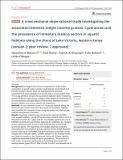| dc.contributor.author | Getachew E Bokore, Paul Ouma, Patrick O Onyango, Tullu Bukhari, Ulrike Fillinger | |
| dc.date.accessioned | 2022-01-21T09:54:50Z | |
| dc.date.available | 2022-01-21T09:54:50Z | |
| dc.date.issued | 2020 | |
| dc.identifier.uri | https://repository.maseno.ac.ke/handle/123456789/4444 | |
| dc.description.abstract | Strategies that involve manipulations of the odour-orientation of gravid malaria vectors could lead to novel attract-and-kill interventions. Recent work has highlighted the potential involvement of graminoid plants in luring vectors to oviposition sites. This study aimed to analyse the association between water-indicating graminoid plants (Cyperaceae, sedges), other abiotic and biotic factors and the presence and abundance of early instar Anopheles larvae in aquatic habitats as a proxy indicator for oviposition. | en_US |
| dc.publisher | Faculty of 1000 Ltd | en_US |
| dc.subject | Anopheles, oviposition, larval ecology, malaria, vector control, vegetation, graminoid plants | en_US |
| dc.title | A cross-sectional observational study investigating the association between sedges (swamp grasses, Cyperaceae) and the prevalence of immature malaria vectors in aquatic habitats along the shore of Lake Victoria, western Kenya | en_US |
| dc.type | Article | en_US |

